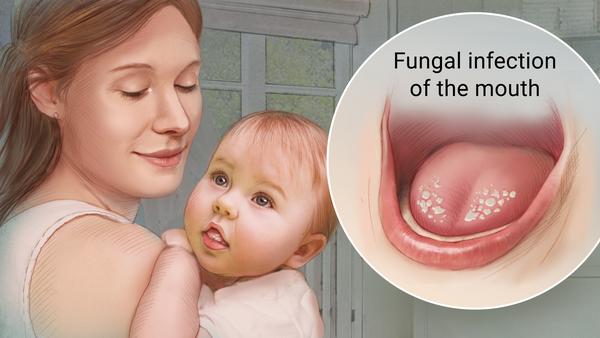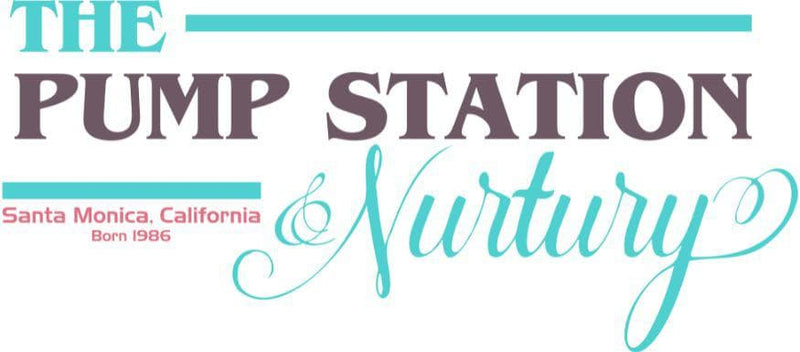Thrush and Breastfeeding

What is Thrush and How Does it Affect Breastfeeding?
Thrush is an irritating yeast infection caused by the fungus Candida albicans. Although this fungus occurs naturally in all human bodies, certain conditions allow it to grow unchecked, which leads to a thrush infection. These conditions include treatment of the mother and/or infant with antibiotics, cracked nipples, use of oral contraceptives and diabetes. It is most commonly seen in the mouth of newborns and babies less than six months of age; it also causes diaper rash, sore nipples and vaginal yeast infections.
Symptoms
Infants normally have a white coating on their tongue, particularly after feedings. But with thrush an infant will have creamy white dots or patches that appear inside the cheeks, on the gums, tongue and lips. These patches look like "spit-up," but it does not wipe or scrape away easily without causing bleeding. In addition, the baby may have a fiery red diaper rash that does not respond to OTC diaper rash remedies. The baby may be excessively gassy, repeatedly pulling off the breast during feedings. The baby may even refuse to nurse altogether because his mouth is sore.
The mother may experience a sudden onset of acute nipple pain during feedings, which may continue even after the feeding is finished. The pain is often described as "burning" and does not improve with better latch or positioning techniques. Shooting pain deep within the breast may also occur and sometimes radiate into the back, shoulder or armpit. Nipples may appear shiny or flaky, and may have a rash of tiny blisters extending onto the areola. There may also be apparent cracks in the nipple, particularly where the nipple and areola meet. Occasionally there are no apparent symptoms. A mother could also be experiencing a vaginal yeast infection.
Treatment
Call both your OB and your Pediatrician for assessment and treatment. If thrush is diagnosed, both mother and baby must be treated with medication prescribed by their health care providers. It is important to note that even if either mother or baby has no visible symptoms; both must be treated simultaneously to prevent reinfection. Treatment must be continued for at least 14 days even if symptoms disappear earlier.
Infant:
- Most pediatricians treat thrush with oral Nystatin suspension which must be applied to all affected areas. Do not put the medicine dropper in the baby's mouth; instead place the dose in a small, washable dish and use a Q-tip to apply.
- Gently wipe out the infant's mouth with a moistened gauze pad after each feeding and before applying the medication.
- Boil all pacifiers, bottle nipples, and pump parts for 10 minutes each day, or use Medela Quick Clean Microwave Steam Bags.
- Wash the baby's hands often, particularly if the hands are in the mouth.
- For a diaper rash yeast infection, wash baby's bottom with warm, mild soapy (not antibacterial) water, and then rinse with a vinegar and water solution (1 tbsp white vinegar/1 cup of water). Pat dry or use a hair dryer on a low setting to dry the area. Apply an antifungal cream such as Mycolog, Lotrimin, or Motherlove Diaper Balm before diapering. Your pediatrician can prescribe a treatment.
- Expose baby's bottom to the air several times a day.
- An alternative remedy to the antifungal medication is to prepare a paste of baking soda and water (1 tbsp baking soda with 3 tbsp water). Apply this solution to the affected areas in the baby's mouth with a Q-tip. This remedy may also be used on the mother's nipples or the baby's bottom.
- Many physicians treat nipple thrush with a prescriptive Nystatin cream. However, other OTC (over the counter) medications may be more effective. Mycolog ointment or vaginal yeast medication such as, Monistat 7, Lotrimin AF, or Micatin are all good options.
- Another treatment choice is All Purpose Nipple Ointment (APNO). It combines an antifungal, an antibiotic, and a calming steroid. A pharmacist can compound it with a prescription from your doctor. You can provide your physician with the ingredients listed below at the bottom of this handout.*
- You can also use OTC medication to make APNO yourself. This mixture may not be as effective as the prescriptive APNO. Mix:
- Antibiotic: Bacitracin or Polysporin (not Neosporin)
- Anti-fungal: Lotrimin AF (clotriamzole) or Monistat (miconazole)
- Anti-inflammatory: Hydrocortisone 1%
- Whichever medication you use, apply medication after each feeding and remove before feeding again. Use a cotton ball soaked in olive oil to remove the medication.
- After nursing, rinse your nipples in a solution of 1 cup water mixed with 1 tbsp of white vinegar or baking soda. Pat dry and apply antifungal cream.
- Instead of a topical cream your doctor may prescribe an oral antifungal medication such as Diflucan (Fluconazole) to be taken daily for 14 days.
- To help relieve nipple pain mix an equal amount of 1% hydrocortisone cream (OTC) with the topical antifungal cream and apply to your nipples and areola.
- Wear wide-based, hard, Medela nipple shells to prevent your bra from sticking to your sore nipples; or use soft, disposable nursing pads changed at every feeding.
- Wash your hands frequently. Use paper towels for drying
- Change bra daily.
- Reducing consumption of dairy products, heavily sweetened foods and processed carbohydrate foods can be helpful.
- Probiotics can build good bacteria in the digestive track and help clear the body of the overgrowth of yeast. A reliable brand is Healthy Trinity by Natren; take as directed or follow the directions on the bottle.
- There are safe probiotics available for babies too.
- Another immune system booster is Echinacea. Buy a quality brand such as Nature's Way and take 3 to 4 capsules a day.
- Because freezing does not kill yeast, any milk frozen during the infection will need to be boiled before being given to the baby. It could also be used later when the baby's immune system is stronger. Milk pumped during the infection, but not frozen, can be fed to the baby within 24 hours of pumping.
Alternative Treatment/Gentian Violet
Gentian Violet is an antifungal that is a very old treatment for thrush. Dr. Jack Newman, a Canadian Pediatrician and breastfeeding expert, states it can be very effective when used in conjunction with All Purpose Nipple Cream.
Please be aware: In the US the solution sold is often a 2% solution which is too strong, and probably accounts for the mouth ulcers that some babies get after being treated with it. The pharmacist should dilute it for you.
Canadian Breastfeeding Foundation Candida Thrush
Revised by Edith Kernerman, IBCLC, and Jack Newman, MD, FRCPC© 2009
*Prescriptive All Purpose Nipple Cream
The ingredients are as follows:
- 100,000 units/ml Nystatin (15 grams)
- 0.1% Betamethasone (15 grams)
- 2% Mupirocin ointment (15 grams)
- 10% Clotrimazole (vaginal ointment) (15 grams)
ALSO SEE: Plugged or Clogged Milk Ducts and Mastitis: The Latest Treatment Tips
See Other Breastfeeding and Baby Care Help Topics



